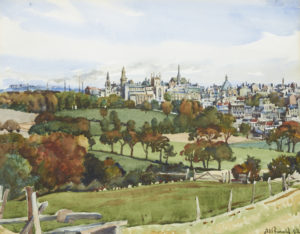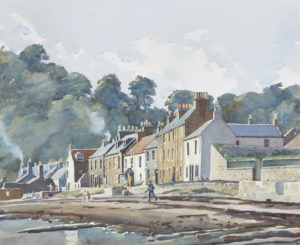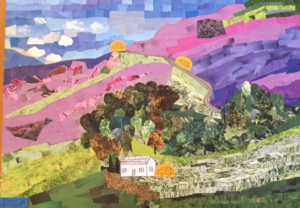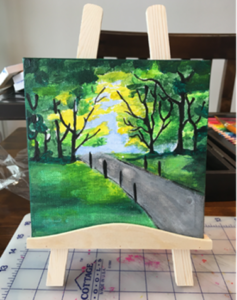
The Recording Scotland collection is a set of watercolours, oils and drawings collected during World War II to permanently capture the “feeling” of the nation. Each piece of artwork was chosen because it captured an essential view of Scotland; with emphasis on the places most likely threatened by war and industrialization. This is the final blog in the series of blogs about different aspects of the Recording Scotland collection.
And so this clear October morning light smiles on a young vigorous Alma Mater of a city, whose children gather around her knee. There is something of fairy-tale about the sudden flash of a red gown in a grey street, then the flash of another, and then a surging of red gowns, where there are good shouting and good laughter, and hope and happiness, as if out of the hill the children had all come back to Hamelin Town. But the hills from which they come are many and wide spread across all the world.
–J.B. Salmond (pg. 38 Recording Scotland)
In St Andrews the autumn is marked by a subtle changing of colours as wheat ripens in the surrounding fields and trees turn shades. The annual Lammas market at the beginning of August also heralds the shift from the intensity of summer to the new academic year. Historically, the Lammas market was one of four annual fairs that brought performers and entertainments to Market Street. It was a time for games, races, and the buying and selling of livestock and goods. Students returning to town are the next indicators of autumn, as they settle into their academic homes to begin their studies once again. Throughout Scotland celebrations of Marymass, Michaelmass Day, highland games, Samhain, and bonfire night all take place in the autumn months leading up to St Andrews day on 30 November. Each observance has its own traditions and legacies that are rich for exploration. We can see the same autumnal shift in colours in the painting “Autumn in Dunfermline” by Alan Ian Ronald and can imagine all the same traditions being observed across Scotland over the years.
By the fall of 1952, the Recording Scotland committee had fulfilled its mission. A book featuring highlights of the collection had been published, the fifth in the series of Recording Britain. While the book captured the outlines of the Scottish collection, the cutting-edge printing techniques used to reproduce the paintings failed to accurately capture the vibrancy of the real works by today’s standards.
The paintings which had travelled extensively and been reproduced, were now in need of a permanent home. Realizing that they were out of funds for insurance or other expenses, the pieces could no longer travel to distant parts of the country. The collection held 145 pieces and posed a challenge for any institution that might take it on.

Luckily, a suggestion was made to donate the paintings to the University of St Andrews in honour of Sir James Irvine, the former committee member and Principal of the university, who had passed away earlier in the year. The works were originally donated to hang in residence halls to act as inspiration for future generations of students.
Sir James, the great advocate of the collection, died in June and was buried not far from the St Andrews Cathedral in the eastern cemetery near the harbour. J.B. Salmond, the archivist and poet, lived another six years. Stephen Edward Harkness, the great benefactor of the university, had passed away in 1940, but his legacy continues through the work of the Pilgrim Trust. Harkness is commemorated on campus by a stained glass window in St Salvator’s Hall, the building whose construction he also funded in the 1930s. To learn more about the stained glass on campus, check out https://www.st-andrews.ac.uk/about/history/st-salvators/stained-glass/
Today, the Recording Scotland collection remains a challenging reminder of the nation’s past; including visual representations of some of its greatest loves and fears. Love for the history carved in wood and stone, love for farmers and fishmen (and women) who fed the nation, and fears of losing those places and occupations to the ravages of time and modernization. Thankfully many of the fears that the Recording Scotland committee held in the 1940s, proved ungrounded, as many of the places survived the war and advancement of time up to today. For the places that did succumb, the lessons remain clear to cherish what remains, and to honour the memories of those that went before.
Salmond’s poem from the Recording Scotland volume, featured under the image of “The Castle of St. Andrews” captures one last sentiment on the art and ancient history of St Andrews; “Perhaps it likes best to remember that in its heyday, as now in its ruins, it acted and acts as a schoolroom for scholars.” All of St Andrews continues to be a schoolroom for scholars, and the museums of the university hope to encourage students and tourists alike to visit and learn more about more amazing stories that this place has to share.
Recording Scotland – Today!

Recently we have been lucky enough to be invited to feature some new works by young artists who participated in the University of Edinburgh’s summer workshop “Capturing Lives in Scotland’s Communities-An Arts Award Explore Online Project.” Students aged 11-18 worked with university museums staff to learn about different themes and media styles. St Andrews helped during the landscape week with information about the Recording Scotland collection. While these pieces are not part of our museum collection, they give us a sneak peek at up and coming artists and we could not resist sharing their landscape artworks. These talented young people are following in the footsteps of the Recording Scotland artists and here is the University of Edinburgh Museum’s Community Outreach Coordinator Laura Beattie’s explanation of the student art.
“During our week on landscape painting, we looked at many different landscape paintings and discussed the different techniques used to make them: some were abstract, like Karen Goode’s Untitled work from Duncan of Jordanstone’s College of Art and Design, which elicited many different responses. Some of us found it scary or threatening while others found it calming. We also looked at work which aimed to be more representational, like those in the University of St Andrews’ ‘Recording Scotland’ collection. We agreed that, given the context of the collection, it was important for the works to be at least somewhat realistic. Our young artists then went on to create their own landscape artworks inspired by the works we had looked at.”

To learn more about the Recording Scotland collection, you can read Recording Scotland, ed. James B. Salmond, 1952. “Recording Britain,” ed. Gill Saunders, 2011. James Colquhoun Irvine: St Andrews’ Second Founder by Julia Melvin, 2011.